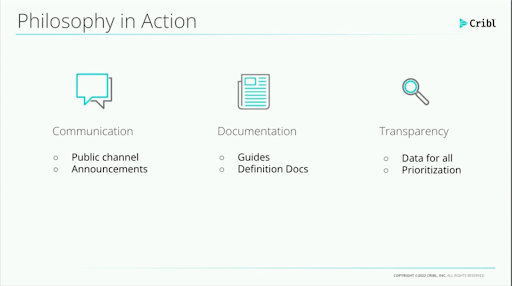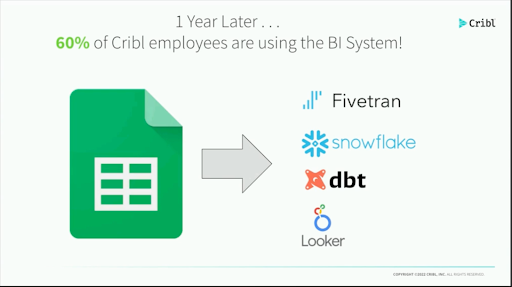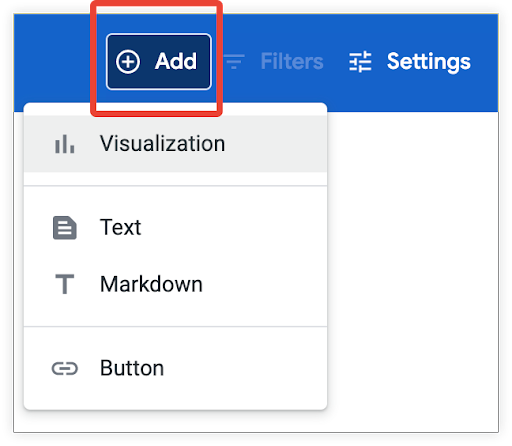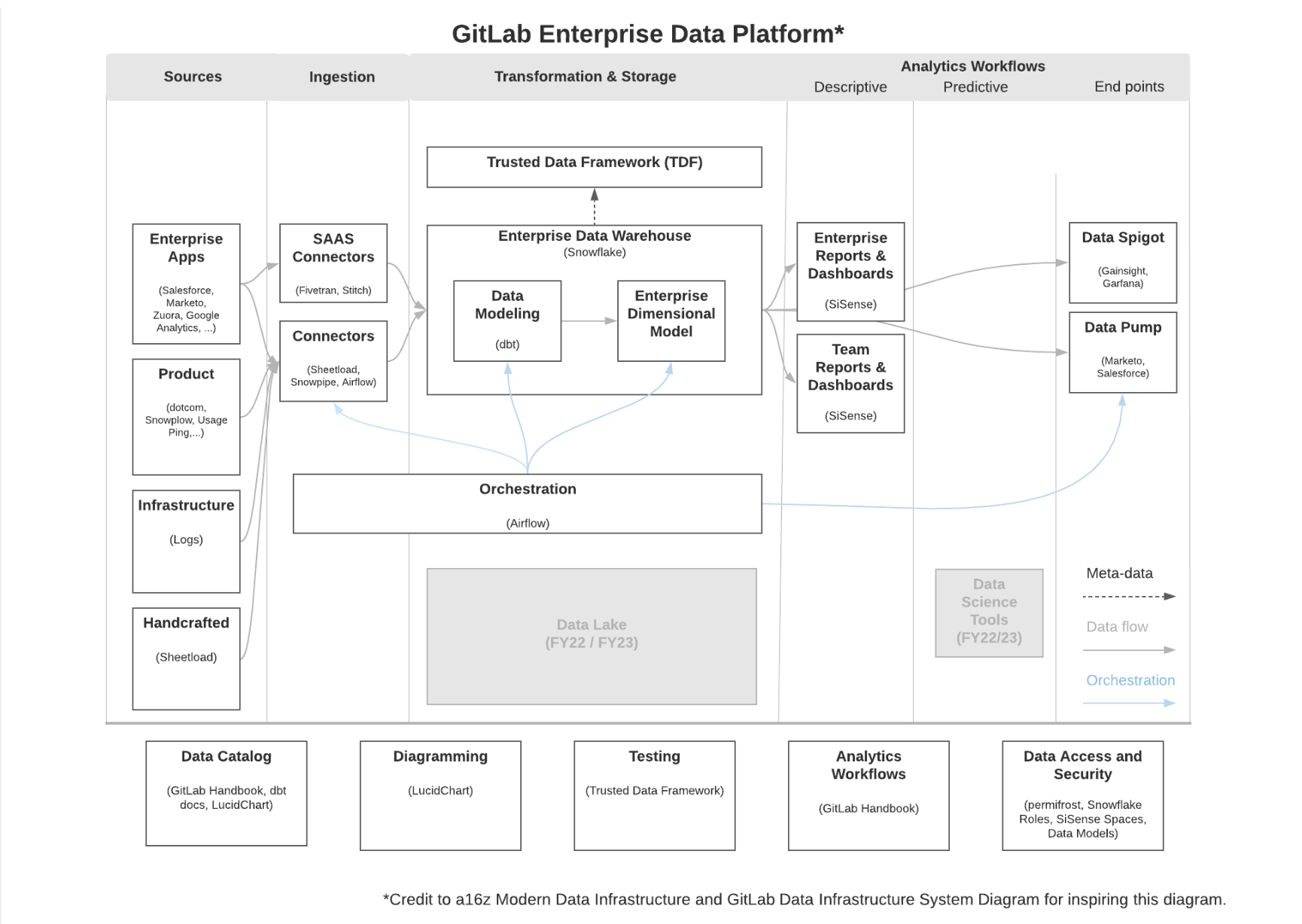The 7 Tenets Of Building A Data-Driven Culture

I run the centralized data function at Cribl, a fast growing company that ensures customers have control over their observability data (editor note: it’s a different kind of observability which we’ve even discussed on the informative Cribl podcast).
Data-driven culture is the breadth and depth of an organization’s use of data as part of its day to day operations. Without a robust data-driven culture, it’s hard for data teams to deliver value at scale.
Don’t get me wrong, it’s difficult to create a data-driven culture without giving stakeholders fast access to reliable data. And to do that, it’s helpful to build a data platform to automate tedious tasks and ensure any mistakes made by a fast moving team are caught and resolved quickly. At Cribl, we a modern data stack using Fivetran for ingestion, dbt for transformation, and Looker for visualization.
While the data stack plays a role in creating our data-driven culture, it was really the data philosophy that glued our strategy together and drove adoption.
To accomplish this, my team abides by 7 key tenets that have transformed data from once a week updates captured in Google Sheets, to a critical asset used by 60 percent of our employees every month.

Table of Contents
- Tenet 1: Treat data like a product
- Tenet 2: A data product needs users
- Tenet 3: Packaging drives adoption
- Tenet 4: Communication builds trust
- Tenet 5: Documentation should empower, not overwhelm
- Tenet 6: Terminology scales understanding
- Tenet 7: Data is for everyone
- Next step? A data driven culture goes viral
Tenet 1: Treat data like a product
One of the hottest concepts among data teams is the idea of building data products or data-as-a-product.
We have internalized this data-as-a-product mythos by scoping out larger initiatives and getting stakeholders to buy-in early. This ensures any piece of data we invest our time to bring into our environment and make available will have some sort of value.
Tenet 2: A data product needs users
And what’s a product without users? If you build a product that no one uses then you haven’t added value.
We religiously track user adoption of our data products as one of our primary success metrics. We also iterate and create minimum viable data products to deliver something of value before tackling the more time consuming, difficult components of a request.
This allows us to see if what we’re building is in the right direction, which again we measure by user adoption, before we have invested too much time.
Tenet 3: Packaging drives adoption
When you are treating data-as-a-product to build a data driven culture, you want to make sure data is packaged the best way possible for your users. This is what differentiates your team and provides a competitive advantage compared to the cookie-cutter reporting most SaaS tools provide out-of-the-box.
For example, Salesforce has great reporting capabilities, but there is much that can be done to add value. One component to look at is how people are treated. In Salesforce, a person can have two records as a “lead” and as a “contact,” but they are still just one person.
It’s a quick win for the data team to extrapolate value for more granular analysis by combining those two concepts together in a single table called “persons” where a person is either a lead or a contact.
In order to understand how to package data to deliver the maximum value possible, you need to have a very intimate understanding of your users and how they view their part of the business.

A great example of this is how every company has a marketing funnel, but every company’s marketing funnel is very different and driven by their particular go-to-market philosophy. At Cribl, the data team invested time to make sure we understand the pipeline and the details around criteria such as sales qualified lead and other key metrics.
Tenet 4: Communication builds trust
Our data team errs on the side of overcommunication, and we try to communicate across as many channels as possible. Just like we as data engineers look askance at a data source that isn’t well documented, business users are going to be inherently skeptical towards quiet data teams.
Modern persistent chat applications like Slack or Teams are very helpful in this regard. We create a centralized channel for all requests, which serves two purposes. It gives the entire analytics team visibility into requests, and it allows for other stakeholders to see what their peers are interested in.
The most satisfying thing you’ll ever see is when someone makes a request in your public Slack channel and then another stakeholder response answers the question that was meant for you. That in a nutshell is how building a data driven culture scales the impact of a data team.
We also use that central, transparent space to make announcements for new data sources, new dashboards, definitions, and even maintenance that could impact dashboards. Providing this level of visibility is important to show your team’s attention to detail, which will build trust for the inevitable moment when a stakeholder runs into incorrect data. And when that does happen, we are transparent during the root cause analysis and triage process as well to demonstrate our commitment to quality and to our customers.
Tenet 5: Documentation should empower, not overwhelm
Few data professionals get out of their bed each morning excited to write some documentation. It’s a necessary evil, but it is necessary. At Cribl, we have a goal for everyone on the team to dedicate 30 minutes each week toward developing and surfacing documentation.
We ensure our documentation is cross-linked everywhere, tied to our onboarding (any HR pro will tell you how important onboarding is to company culture!), and comprehensive. We will list each data source with a brief description to see where data is coming from, in what frequency, and what business rules are being applied on top of that data.
One key step to take is to import this knowledge and documentation into your BI tool (we use Looker) wherever possible in the form of markdown and info icons. This helps end users interpret what they are seeing as they are seeing it. You would be surprised how impactful adding a markdown tile or a description to a field is for your end users. We now get requests to add information icons to better explain a chart, which creates an awesome feedback loop.

This dramatically lowers the amount of time the data team spends handling internal questions and empowers our customers by giving them the confidence that they can understand, interact, and interpret the data to make better informed decisions.
Tenet 6: Terminology scales understanding
One of the last tenants to building a data driven culture is standardizing terminology. To do that, you need to get stakeholder signoff on that terminology. It doesn’t matter if everyone on the data team calls it a form submission if the marketing team is referring to it as a lead.
It is especially important to provide shared understanding into the methodology of how metrics are built. A great example here is CSAT or your customer satisfaction score. There are three different ways to measure CSAT that are prevalent across our industry. Standardizing this definition ensures folks are able to make apples to apples comparisons.
Another example is the definition of open pipeline, which can change as a company grows. Change is expected and dealing with that change is monumental. When the definition changes, it needs to change to everyone and in all systems that your consumers access that data (e.g. Salesforce).
Tenet 7: Data is for everyone
Customer first and transparency are Cribl values that our executive team has instilled company wide. Our goal is to be transparent with data so that every employee has access to it.
We will take requests from every single employee–we may not get to it right away, but we will create a JIRA ticket to track it in our system and give the requester a transparent timeline of when we will be able to address their ticket.
Next step? A data driven culture goes viral
This is by no means a comprehensive list, but these core principles have worked well for our fast-growing startup, and can be applied across industries and team structures.
We’re still early in our data journey and I’m looking forward to seeing the heights to which our company can reach when we are all working together with reliable data at our fingertips.
##
Curious about how data observability can help you gain stakeholder trust and build a data driven culture? Set up a time to talk to us by filling out the form below.
Our promise: we will show you the product.
 Product demo.
Product demo.  What is data observability?
What is data observability?  What is a data mesh--and how not to mesh it up
What is a data mesh--and how not to mesh it up  The ULTIMATE Guide To Data Lineage
The ULTIMATE Guide To Data Lineage 





